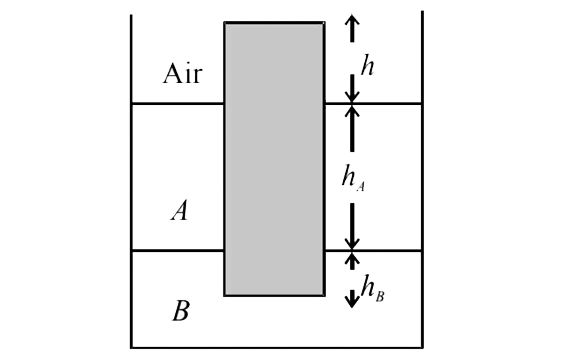A uniform solid cylinder of density 0.8g/cm3 floats in equilibrium in a combination of two non-mixing liquids A and B with its axis vertical.
The densities of the liquids A and B are 0.7g/cm3 and 1.2g/cm3, respectively. The height of liquid A is hA=1.2cm. The length of the part of the cylinder immersed in liquid B is hB=0.8cm.

(a) Find the total force exerted by liquid A on the cylinder.
(b) Find h, the length of the part of the cylinder in air.
(c) The cylinder is depressed in such a way that its top surface is just below the upper surface of liquid A and is then released. Find the acceleration of the cylinder immediately after it is released.
The correct Answer is:(a)0,(b)h=0.25cm,(c)a=g/6(upward)
(a) Liquid A is exerting force on the cylinder symmetrically from all sides. Therefore net force is zero.
(b) Weight = Buoyancy
mg=Buoyancy of liquid A+ Buoyancy of liquid B
(h+hA+hB)Aρg=hAρAAg+hBρBAg
h=0.25cm
(c ) W−B=ma
[hAAρAg+(hB+h)AρBg]−(h+hA+hB)Aρg=(h+hA+hB)ρA
hρBg=(h1+hA+hB)ρ
0.25×1.2×g=(0.25+1.2+0.8)×0.8×a
0.25×1.2×g=2.25×0.8a
a=g6
Topper's Solved these Questions
- FLUID MECHANICSBOOK - BANSALCHAPTER - FLUID MECHANICSEXERCISE - MCQ & Solution
86 Videos
- FLUID MECHANICSBOOK - BANSALCHAPTER - FLUID MECHANICSEXERCISE - PYQS AIEEE
10 Videos
- FLUID MECHANICSBOOK - BANSALCHAPTER - FLUID MECHANICSEXERCISE - EXERCISE # II
18 Videos
- MASTER PRACTICE PROBLEMBOOK - BANSALCHAPTER - MASTER PRACTICE PROBLEMEXERCISE - Additional topic
70 Videos
Similar Questions
A jar contains two immiscible liquids A and B with a coin at its bottom. The depths of liquid A and liquid B are 6 cm and 8 cm, respectively. If the apparent depth of the coin is 9 cm and refractive index of liquid A is 1.5, what is the refractive index of liquid B?
View SolutionA column of water 40cm height supports a 30cm column of an unknown liquid . What is the density of the liquid ?
View Solution
Knowledge Check
Choose the most appropriate options.
Argon crystallises in fcc arrangement and the density of solid and liquid Ar is 159g/cm3and1.42g/cm3, respectively. The percentage of empty space in liquid Ar isA34.84%B43.8%C23.4%D21.6%The density of a liquid at 100∘C is 8.0g/cm3 and at 0∘C is 8.4g/cm3, the coefficient of cubical expansion of the liquid is
A10−4/∘CB5×10−4/∘CC8×10−4/∘CD4×10−4/∘CAn object of relative density 0 . 75 is floating in a liquid with 500cm3 of the object inside the liquid . Find the total volume of the object, if the relative density of liquid is 1 . 0 2
A60cm3B680cm3C700cm3D740cm3
Two miscible liquids of densities 1.2gm/cm and 1.4gm/cm aer mixed with a proportion ratio of their volumes equal to 2.5: what is the density of redulting liquid?
View SolutionTwo identical tanks contain water and a liquid of density 0.8gcm−3. Pressure exerted by the liquid is equal to the pressure due to water column of 50 cm. Find the height of the liquid column in the tank ?
View SolutionTwo immiscible of densities 2.5g/cm3 and 0.8g/cm3 are taken in the ratio of their masses as 2:3 respectively find the average density of the liquid conbination.
View SolutionTwo identical containers A and B are filled with two different liquids of equal masses. The level of the liquid in container A is found to be one-fourth of the level of the liquid in container B. What is the ratio of thedensity of two liquids? If the density of he liquid in the container A is 2 " g "cm−3, then find the density of the mixture of the two liquids.
View SolutionWhen 100 drops of a liquid P is added into a liquid Q the volume of the liquid in the container which is initially filled with liquid Q doubled. Determined density of the mixture if density of the liquids P and Q are 1.5 g cm ^(-3) and 1.3 g cm^(-3), respectively
View Solution
